Detailed Analysis of Contract and Negligence Law in Business
VerifiedAdded on 2019/12/03
|11
|3342
|214
Report
AI Summary
This report delves into the intricacies of English contract and negligence law, providing a detailed analysis of its provisions through two distinct case scenarios. The first scenario examines the formation of a contract, including essential elements like offer, acceptance, consideration, and intention, along with different types of contracts such as contracts for the supply of goods. It explores the applicability of contractual terms, including express and implied terms, conditions, warranties, and exclusion clauses, offering advice on the validity of exclusion clauses. The second scenario focuses on negligence law, differentiating it from contract obligations, outlining the elements required for a successful negligence claim, and providing legal advice related to personal injuries, defenses, and vicarious liability. The report concludes with recommendations based on the legal principles discussed, offering a comprehensive understanding of both contract and negligence law in commercial contexts.
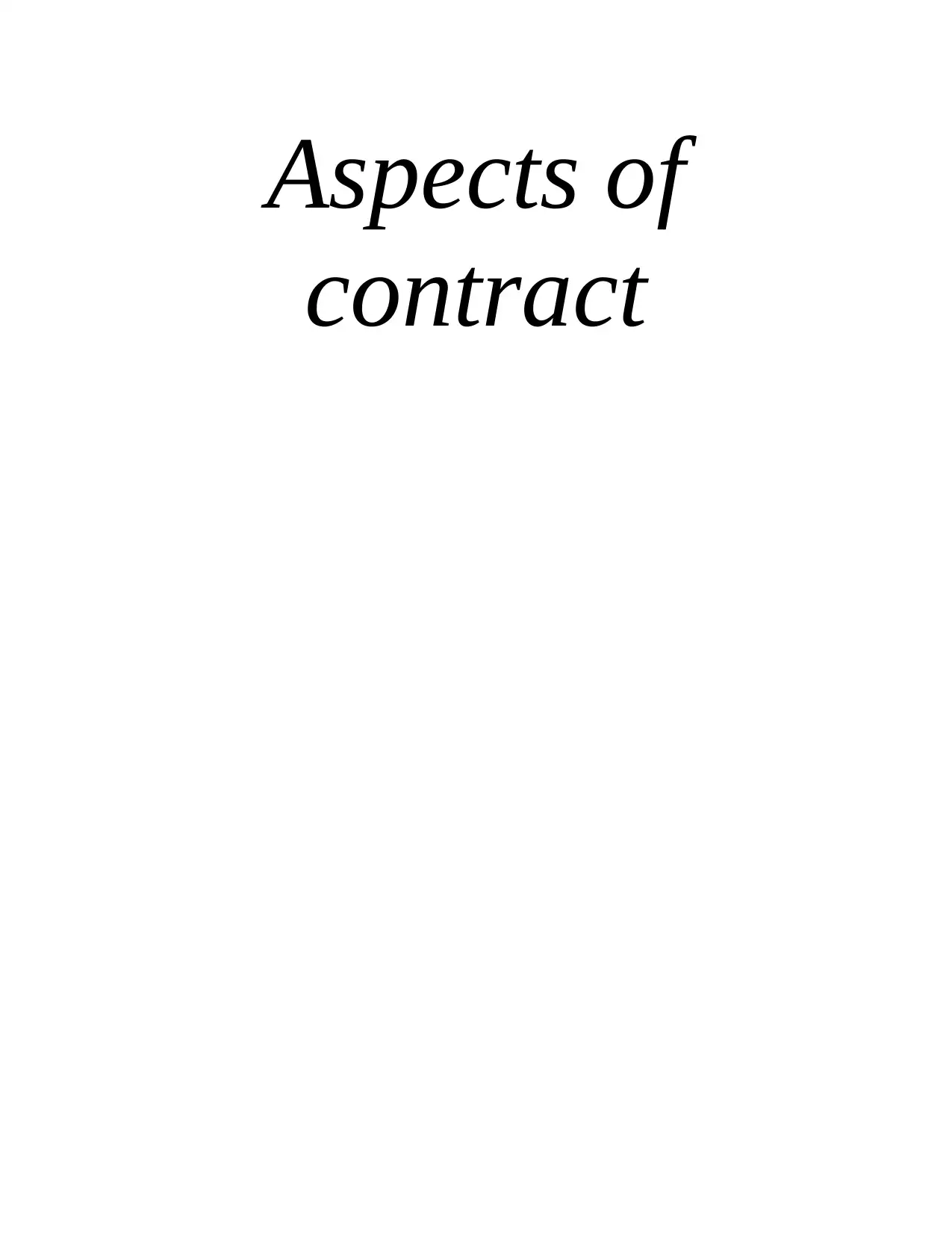
Aspects of
contract
contract
Paraphrase This Document
Need a fresh take? Get an instant paraphrase of this document with our AI Paraphraser

TABLE OF CONTENTS
Introduction......................................................................................................................................3
Scenario 1.........................................................................................................................................3
1. Essential elements required for the formation of contract.......................................................3
2. Description of different types of contract along with the suitable examples...........................4
3. Advise of InXs for prevailing of contract................................................................................5
4. Applicability of contractual terms in the given case scenario.................................................5
5. Validity of exclusion clause inserted by CP in the contractual deed.......................................6
Scenario 2.........................................................................................................................................8
1. Difference between contract and negligence obligations........................................................8
2. Elements that required to be presented by claimant in order to succeed in an action for
negligence....................................................................................................................................8
3. Advice to Fiona regarding her claim of personal injuries ......................................................8
4. Defenses for country pine........................................................................................................9
5. Doctrine of vicarious liability..................................................................................................9
6. Advice to CP regarding damages caused by Jason..................................................................9
Conclusion.......................................................................................................................................9
References......................................................................................................................................10
2
Introduction......................................................................................................................................3
Scenario 1.........................................................................................................................................3
1. Essential elements required for the formation of contract.......................................................3
2. Description of different types of contract along with the suitable examples...........................4
3. Advise of InXs for prevailing of contract................................................................................5
4. Applicability of contractual terms in the given case scenario.................................................5
5. Validity of exclusion clause inserted by CP in the contractual deed.......................................6
Scenario 2.........................................................................................................................................8
1. Difference between contract and negligence obligations........................................................8
2. Elements that required to be presented by claimant in order to succeed in an action for
negligence....................................................................................................................................8
3. Advice to Fiona regarding her claim of personal injuries ......................................................8
4. Defenses for country pine........................................................................................................9
5. Doctrine of vicarious liability..................................................................................................9
6. Advice to CP regarding damages caused by Jason..................................................................9
Conclusion.......................................................................................................................................9
References......................................................................................................................................10
2
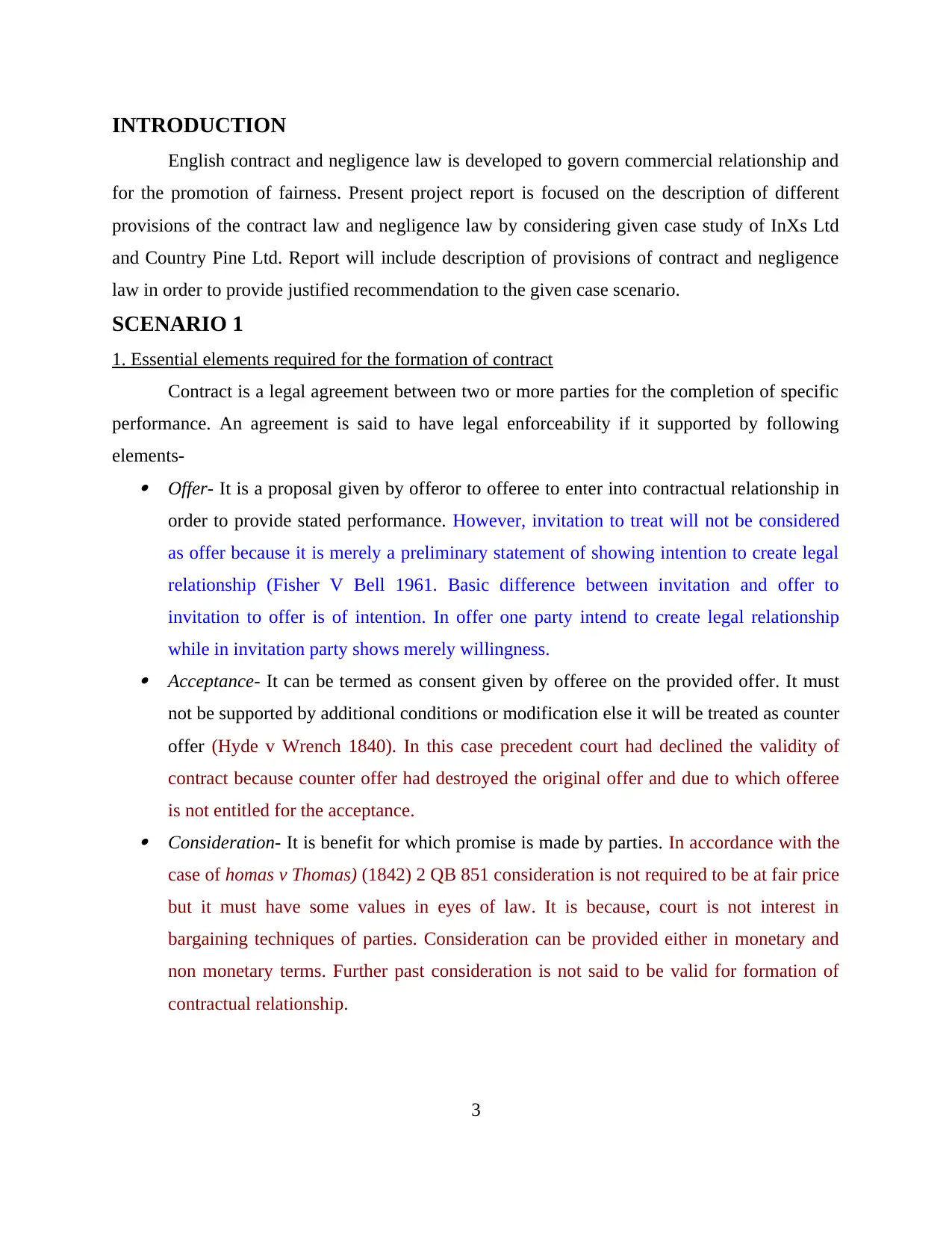
INTRODUCTION
English contract and negligence law is developed to govern commercial relationship and
for the promotion of fairness. Present project report is focused on the description of different
provisions of the contract law and negligence law by considering given case study of InXs Ltd
and Country Pine Ltd. Report will include description of provisions of contract and negligence
law in order to provide justified recommendation to the given case scenario.
SCENARIO 1
1. Essential elements required for the formation of contract
Contract is a legal agreement between two or more parties for the completion of specific
performance. An agreement is said to have legal enforceability if it supported by following
elements- Offer- It is a proposal given by offeror to offeree to enter into contractual relationship in
order to provide stated performance. However, invitation to treat will not be considered
as offer because it is merely a preliminary statement of showing intention to create legal
relationship (Fisher V Bell 1961. Basic difference between invitation and offer to
invitation to offer is of intention. In offer one party intend to create legal relationship
while in invitation party shows merely willingness. Acceptance- It can be termed as consent given by offeree on the provided offer. It must
not be supported by additional conditions or modification else it will be treated as counter
offer (Hyde v Wrench 1840). In this case precedent court had declined the validity of
contract because counter offer had destroyed the original offer and due to which offeree
is not entitled for the acceptance. Consideration- It is benefit for which promise is made by parties. In accordance with the
case of homas v Thomas) (1842) 2 QB 851 consideration is not required to be at fair price
but it must have some values in eyes of law. It is because, court is not interest in
bargaining techniques of parties. Consideration can be provided either in monetary and
non monetary terms. Further past consideration is not said to be valid for formation of
contractual relationship.
3
English contract and negligence law is developed to govern commercial relationship and
for the promotion of fairness. Present project report is focused on the description of different
provisions of the contract law and negligence law by considering given case study of InXs Ltd
and Country Pine Ltd. Report will include description of provisions of contract and negligence
law in order to provide justified recommendation to the given case scenario.
SCENARIO 1
1. Essential elements required for the formation of contract
Contract is a legal agreement between two or more parties for the completion of specific
performance. An agreement is said to have legal enforceability if it supported by following
elements- Offer- It is a proposal given by offeror to offeree to enter into contractual relationship in
order to provide stated performance. However, invitation to treat will not be considered
as offer because it is merely a preliminary statement of showing intention to create legal
relationship (Fisher V Bell 1961. Basic difference between invitation and offer to
invitation to offer is of intention. In offer one party intend to create legal relationship
while in invitation party shows merely willingness. Acceptance- It can be termed as consent given by offeree on the provided offer. It must
not be supported by additional conditions or modification else it will be treated as counter
offer (Hyde v Wrench 1840). In this case precedent court had declined the validity of
contract because counter offer had destroyed the original offer and due to which offeree
is not entitled for the acceptance. Consideration- It is benefit for which promise is made by parties. In accordance with the
case of homas v Thomas) (1842) 2 QB 851 consideration is not required to be at fair price
but it must have some values in eyes of law. It is because, court is not interest in
bargaining techniques of parties. Consideration can be provided either in monetary and
non monetary terms. Further past consideration is not said to be valid for formation of
contractual relationship.
3
⊘ This is a preview!⊘
Do you want full access?
Subscribe today to unlock all pages.

Trusted by 1+ million students worldwide

Intention- All parties to the contract, must have intention to create legal relationship for
the fulfilment of promise described by them (Jones v Padavatton [1969] 1 WLR 328).
This element is assumed to be part of the contract because it is not expressly stated by the
parties.
Case scenario
In the given case situation, invitation to treat was given by InXs Ltd to Country Pine Ltd
for providing quotation of furniture for the purpose of refurbishment. By considering the
provided invitation offer was given by the CP for the sale of furniture at £45000. Given scenario
is based on the contract of goods thus in this implied terms of Sales and Goods Act will be
applied. Further, counter offer was given by InXs Ltd by making change in price i.e. £42000.
Along with this, they also sent a written contract to the CP. This contract was not returned by CP
but they had sent email regarding delivery dates along with their standard contract with a
statement that there contract with prevail. This mail was considered by InXs Ltd and it was also
signed by employee and company secretary of the organization. This aspect shows that there is
valid contract between parties as all the essential elements are covered in the agreement formed
by the parties.
2. Description of different types of contract along with the suitable examples
By considering the given case scenario it can be said that there was contract of supply of
goods between InXs Ltd and Country Pine Ltd. It is because, tangible products are transferred by
the parties for the description of terms and conditions. It is conducted in written manner. This is
the most formal form of contract because prepared deed is considered as evidence in order to
resolve dispute among parties and to provide reasonable damages to the innocent party. Along
with the written contract, following contractual forms can be selected by contracting parties for
formation of legal agreement- Contract of employment- This contract is created between employer and employee in
order to determine terms and conditions of the contract. Generally these contracts are
created in written form. Contract of services- Contract of services is created between purchaser and seller for the
transfer of intangible goods. These contracts are governed by Supply of Goods and
4
the fulfilment of promise described by them (Jones v Padavatton [1969] 1 WLR 328).
This element is assumed to be part of the contract because it is not expressly stated by the
parties.
Case scenario
In the given case situation, invitation to treat was given by InXs Ltd to Country Pine Ltd
for providing quotation of furniture for the purpose of refurbishment. By considering the
provided invitation offer was given by the CP for the sale of furniture at £45000. Given scenario
is based on the contract of goods thus in this implied terms of Sales and Goods Act will be
applied. Further, counter offer was given by InXs Ltd by making change in price i.e. £42000.
Along with this, they also sent a written contract to the CP. This contract was not returned by CP
but they had sent email regarding delivery dates along with their standard contract with a
statement that there contract with prevail. This mail was considered by InXs Ltd and it was also
signed by employee and company secretary of the organization. This aspect shows that there is
valid contract between parties as all the essential elements are covered in the agreement formed
by the parties.
2. Description of different types of contract along with the suitable examples
By considering the given case scenario it can be said that there was contract of supply of
goods between InXs Ltd and Country Pine Ltd. It is because, tangible products are transferred by
the parties for the description of terms and conditions. It is conducted in written manner. This is
the most formal form of contract because prepared deed is considered as evidence in order to
resolve dispute among parties and to provide reasonable damages to the innocent party. Along
with the written contract, following contractual forms can be selected by contracting parties for
formation of legal agreement- Contract of employment- This contract is created between employer and employee in
order to determine terms and conditions of the contract. Generally these contracts are
created in written form. Contract of services- Contract of services is created between purchaser and seller for the
transfer of intangible goods. These contracts are governed by Supply of Goods and
4
Paraphrase This Document
Need a fresh take? Get an instant paraphrase of this document with our AI Paraphraser
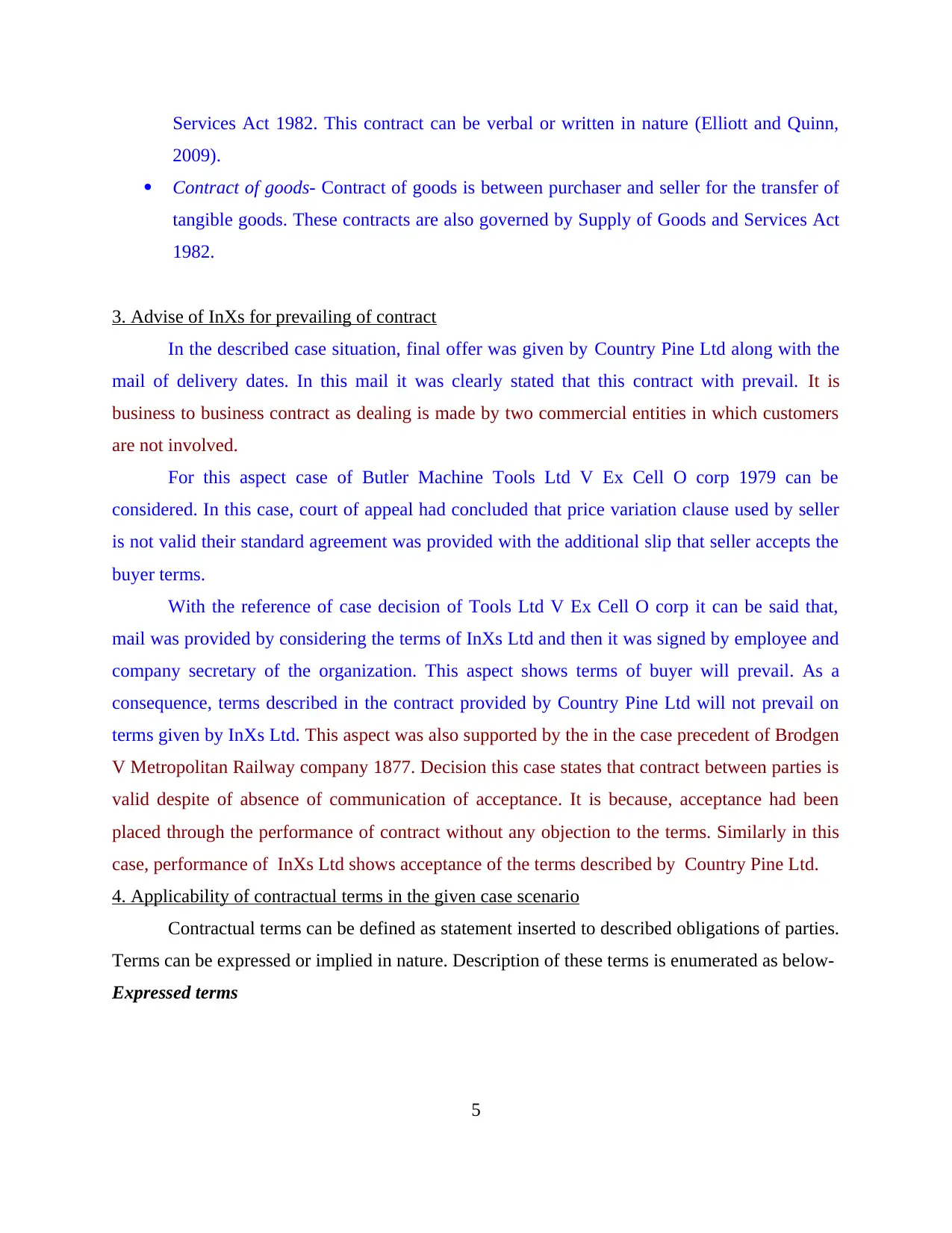
Services Act 1982. This contract can be verbal or written in nature (Elliott and Quinn,
2009).
Contract of goods- Contract of goods is between purchaser and seller for the transfer of
tangible goods. These contracts are also governed by Supply of Goods and Services Act
1982.
3. Advise of InXs for prevailing of contract
In the described case situation, final offer was given by Country Pine Ltd along with the
mail of delivery dates. In this mail it was clearly stated that this contract with prevail. It is
business to business contract as dealing is made by two commercial entities in which customers
are not involved.
For this aspect case of Butler Machine Tools Ltd V Ex Cell O corp 1979 can be
considered. In this case, court of appeal had concluded that price variation clause used by seller
is not valid their standard agreement was provided with the additional slip that seller accepts the
buyer terms.
With the reference of case decision of Tools Ltd V Ex Cell O corp it can be said that,
mail was provided by considering the terms of InXs Ltd and then it was signed by employee and
company secretary of the organization. This aspect shows terms of buyer will prevail. As a
consequence, terms described in the contract provided by Country Pine Ltd will not prevail on
terms given by InXs Ltd. This aspect was also supported by the in the case precedent of Brodgen
V Metropolitan Railway company 1877. Decision this case states that contract between parties is
valid despite of absence of communication of acceptance. It is because, acceptance had been
placed through the performance of contract without any objection to the terms. Similarly in this
case, performance of InXs Ltd shows acceptance of the terms described by Country Pine Ltd.
4. Applicability of contractual terms in the given case scenario
Contractual terms can be defined as statement inserted to described obligations of parties.
Terms can be expressed or implied in nature. Description of these terms is enumerated as below-
Expressed terms
5
2009).
Contract of goods- Contract of goods is between purchaser and seller for the transfer of
tangible goods. These contracts are also governed by Supply of Goods and Services Act
1982.
3. Advise of InXs for prevailing of contract
In the described case situation, final offer was given by Country Pine Ltd along with the
mail of delivery dates. In this mail it was clearly stated that this contract with prevail. It is
business to business contract as dealing is made by two commercial entities in which customers
are not involved.
For this aspect case of Butler Machine Tools Ltd V Ex Cell O corp 1979 can be
considered. In this case, court of appeal had concluded that price variation clause used by seller
is not valid their standard agreement was provided with the additional slip that seller accepts the
buyer terms.
With the reference of case decision of Tools Ltd V Ex Cell O corp it can be said that,
mail was provided by considering the terms of InXs Ltd and then it was signed by employee and
company secretary of the organization. This aspect shows terms of buyer will prevail. As a
consequence, terms described in the contract provided by Country Pine Ltd will not prevail on
terms given by InXs Ltd. This aspect was also supported by the in the case precedent of Brodgen
V Metropolitan Railway company 1877. Decision this case states that contract between parties is
valid despite of absence of communication of acceptance. It is because, acceptance had been
placed through the performance of contract without any objection to the terms. Similarly in this
case, performance of InXs Ltd shows acceptance of the terms described by Country Pine Ltd.
4. Applicability of contractual terms in the given case scenario
Contractual terms can be defined as statement inserted to described obligations of parties.
Terms can be expressed or implied in nature. Description of these terms is enumerated as below-
Expressed terms
5
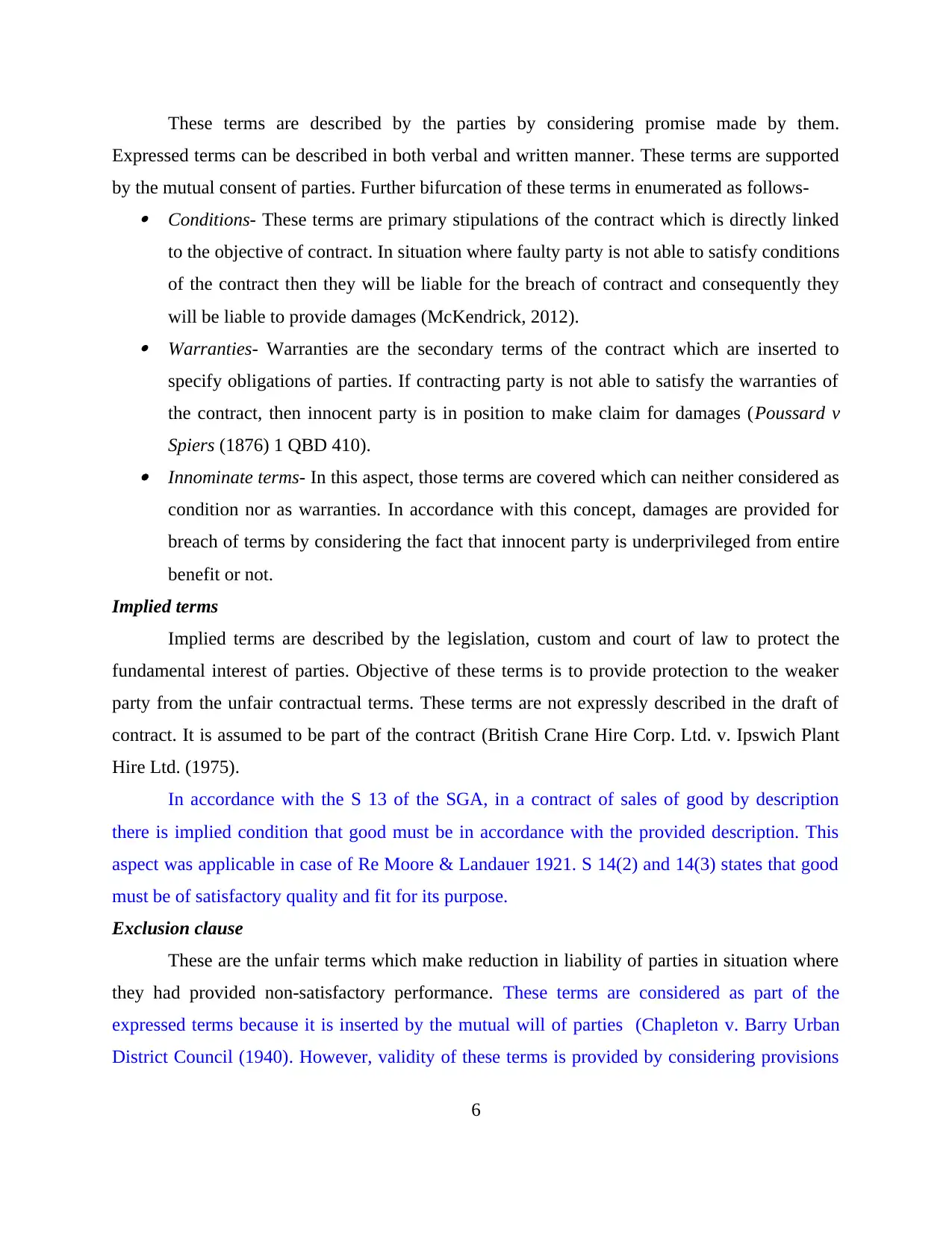
These terms are described by the parties by considering promise made by them.
Expressed terms can be described in both verbal and written manner. These terms are supported
by the mutual consent of parties. Further bifurcation of these terms in enumerated as follows- Conditions- These terms are primary stipulations of the contract which is directly linked
to the objective of contract. In situation where faulty party is not able to satisfy conditions
of the contract then they will be liable for the breach of contract and consequently they
will be liable to provide damages (McKendrick, 2012). Warranties- Warranties are the secondary terms of the contract which are inserted to
specify obligations of parties. If contracting party is not able to satisfy the warranties of
the contract, then innocent party is in position to make claim for damages (Poussard v
Spiers (1876) 1 QBD 410). Innominate terms- In this aspect, those terms are covered which can neither considered as
condition nor as warranties. In accordance with this concept, damages are provided for
breach of terms by considering the fact that innocent party is underprivileged from entire
benefit or not.
Implied terms
Implied terms are described by the legislation, custom and court of law to protect the
fundamental interest of parties. Objective of these terms is to provide protection to the weaker
party from the unfair contractual terms. These terms are not expressly described in the draft of
contract. It is assumed to be part of the contract (British Crane Hire Corp. Ltd. v. Ipswich Plant
Hire Ltd. (1975).
In accordance with the S 13 of the SGA, in a contract of sales of good by description
there is implied condition that good must be in accordance with the provided description. This
aspect was applicable in case of Re Moore & Landauer 1921. S 14(2) and 14(3) states that good
must be of satisfactory quality and fit for its purpose.
Exclusion clause
These are the unfair terms which make reduction in liability of parties in situation where
they had provided non-satisfactory performance. These terms are considered as part of the
expressed terms because it is inserted by the mutual will of parties (Chapleton v. Barry Urban
District Council (1940). However, validity of these terms is provided by considering provisions
6
Expressed terms can be described in both verbal and written manner. These terms are supported
by the mutual consent of parties. Further bifurcation of these terms in enumerated as follows- Conditions- These terms are primary stipulations of the contract which is directly linked
to the objective of contract. In situation where faulty party is not able to satisfy conditions
of the contract then they will be liable for the breach of contract and consequently they
will be liable to provide damages (McKendrick, 2012). Warranties- Warranties are the secondary terms of the contract which are inserted to
specify obligations of parties. If contracting party is not able to satisfy the warranties of
the contract, then innocent party is in position to make claim for damages (Poussard v
Spiers (1876) 1 QBD 410). Innominate terms- In this aspect, those terms are covered which can neither considered as
condition nor as warranties. In accordance with this concept, damages are provided for
breach of terms by considering the fact that innocent party is underprivileged from entire
benefit or not.
Implied terms
Implied terms are described by the legislation, custom and court of law to protect the
fundamental interest of parties. Objective of these terms is to provide protection to the weaker
party from the unfair contractual terms. These terms are not expressly described in the draft of
contract. It is assumed to be part of the contract (British Crane Hire Corp. Ltd. v. Ipswich Plant
Hire Ltd. (1975).
In accordance with the S 13 of the SGA, in a contract of sales of good by description
there is implied condition that good must be in accordance with the provided description. This
aspect was applicable in case of Re Moore & Landauer 1921. S 14(2) and 14(3) states that good
must be of satisfactory quality and fit for its purpose.
Exclusion clause
These are the unfair terms which make reduction in liability of parties in situation where
they had provided non-satisfactory performance. These terms are considered as part of the
expressed terms because it is inserted by the mutual will of parties (Chapleton v. Barry Urban
District Council (1940). However, validity of these terms is provided by considering provisions
6
⊘ This is a preview!⊘
Do you want full access?
Subscribe today to unlock all pages.

Trusted by 1+ million students worldwide
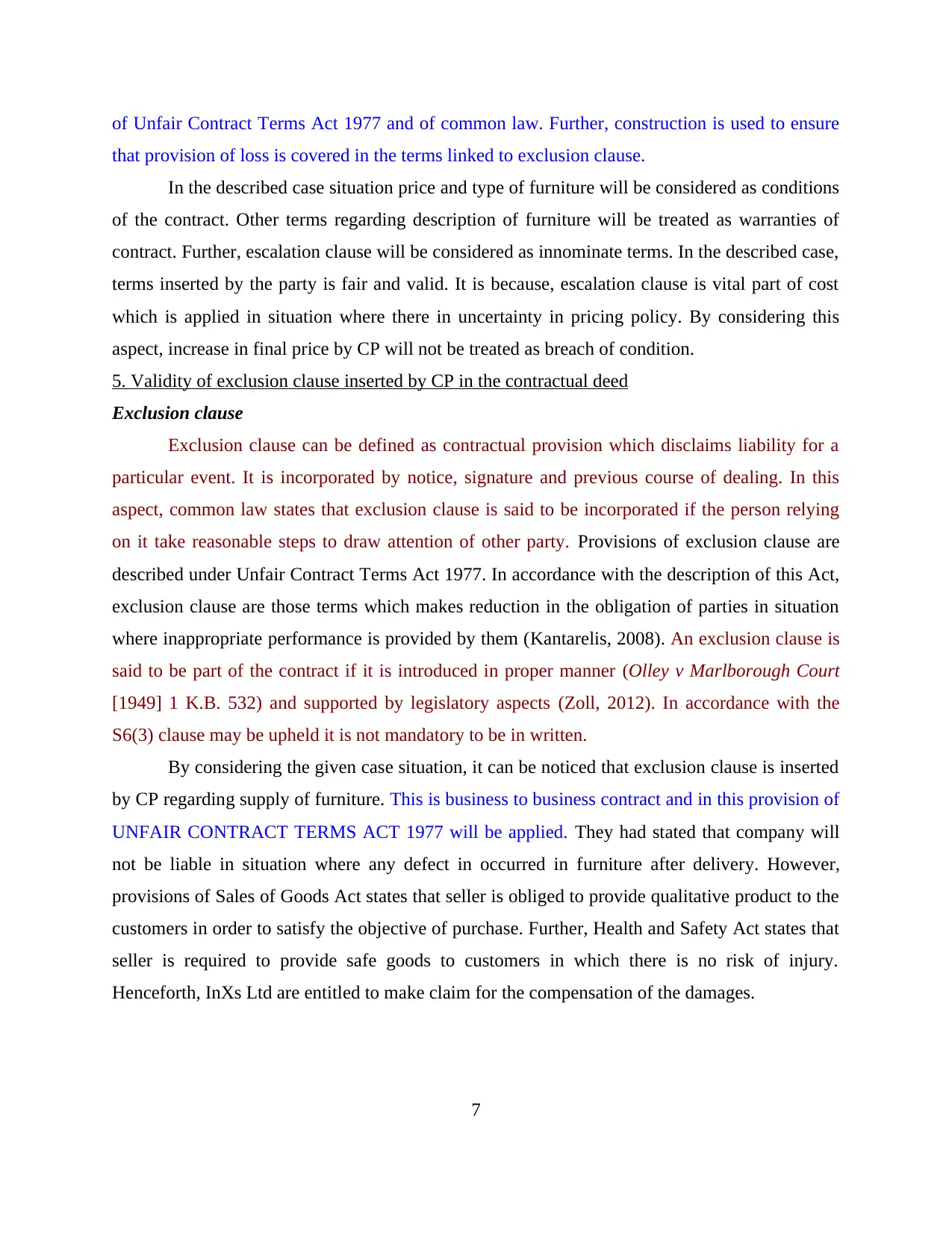
of Unfair Contract Terms Act 1977 and of common law. Further, construction is used to ensure
that provision of loss is covered in the terms linked to exclusion clause.
In the described case situation price and type of furniture will be considered as conditions
of the contract. Other terms regarding description of furniture will be treated as warranties of
contract. Further, escalation clause will be considered as innominate terms. In the described case,
terms inserted by the party is fair and valid. It is because, escalation clause is vital part of cost
which is applied in situation where there in uncertainty in pricing policy. By considering this
aspect, increase in final price by CP will not be treated as breach of condition.
5. Validity of exclusion clause inserted by CP in the contractual deed
Exclusion clause
Exclusion clause can be defined as contractual provision which disclaims liability for a
particular event. It is incorporated by notice, signature and previous course of dealing. In this
aspect, common law states that exclusion clause is said to be incorporated if the person relying
on it take reasonable steps to draw attention of other party. Provisions of exclusion clause are
described under Unfair Contract Terms Act 1977. In accordance with the description of this Act,
exclusion clause are those terms which makes reduction in the obligation of parties in situation
where inappropriate performance is provided by them (Kantarelis, 2008). An exclusion clause is
said to be part of the contract if it is introduced in proper manner (Olley v Marlborough Court
[1949] 1 K.B. 532) and supported by legislatory aspects (Zoll, 2012). In accordance with the
S6(3) clause may be upheld it is not mandatory to be in written.
By considering the given case situation, it can be noticed that exclusion clause is inserted
by CP regarding supply of furniture. This is business to business contract and in this provision of
UNFAIR CONTRACT TERMS ACT 1977 will be applied. They had stated that company will
not be liable in situation where any defect in occurred in furniture after delivery. However,
provisions of Sales of Goods Act states that seller is obliged to provide qualitative product to the
customers in order to satisfy the objective of purchase. Further, Health and Safety Act states that
seller is required to provide safe goods to customers in which there is no risk of injury.
Henceforth, InXs Ltd are entitled to make claim for the compensation of the damages.
7
that provision of loss is covered in the terms linked to exclusion clause.
In the described case situation price and type of furniture will be considered as conditions
of the contract. Other terms regarding description of furniture will be treated as warranties of
contract. Further, escalation clause will be considered as innominate terms. In the described case,
terms inserted by the party is fair and valid. It is because, escalation clause is vital part of cost
which is applied in situation where there in uncertainty in pricing policy. By considering this
aspect, increase in final price by CP will not be treated as breach of condition.
5. Validity of exclusion clause inserted by CP in the contractual deed
Exclusion clause
Exclusion clause can be defined as contractual provision which disclaims liability for a
particular event. It is incorporated by notice, signature and previous course of dealing. In this
aspect, common law states that exclusion clause is said to be incorporated if the person relying
on it take reasonable steps to draw attention of other party. Provisions of exclusion clause are
described under Unfair Contract Terms Act 1977. In accordance with the description of this Act,
exclusion clause are those terms which makes reduction in the obligation of parties in situation
where inappropriate performance is provided by them (Kantarelis, 2008). An exclusion clause is
said to be part of the contract if it is introduced in proper manner (Olley v Marlborough Court
[1949] 1 K.B. 532) and supported by legislatory aspects (Zoll, 2012). In accordance with the
S6(3) clause may be upheld it is not mandatory to be in written.
By considering the given case situation, it can be noticed that exclusion clause is inserted
by CP regarding supply of furniture. This is business to business contract and in this provision of
UNFAIR CONTRACT TERMS ACT 1977 will be applied. They had stated that company will
not be liable in situation where any defect in occurred in furniture after delivery. However,
provisions of Sales of Goods Act states that seller is obliged to provide qualitative product to the
customers in order to satisfy the objective of purchase. Further, Health and Safety Act states that
seller is required to provide safe goods to customers in which there is no risk of injury.
Henceforth, InXs Ltd are entitled to make claim for the compensation of the damages.
7
Paraphrase This Document
Need a fresh take? Get an instant paraphrase of this document with our AI Paraphraser
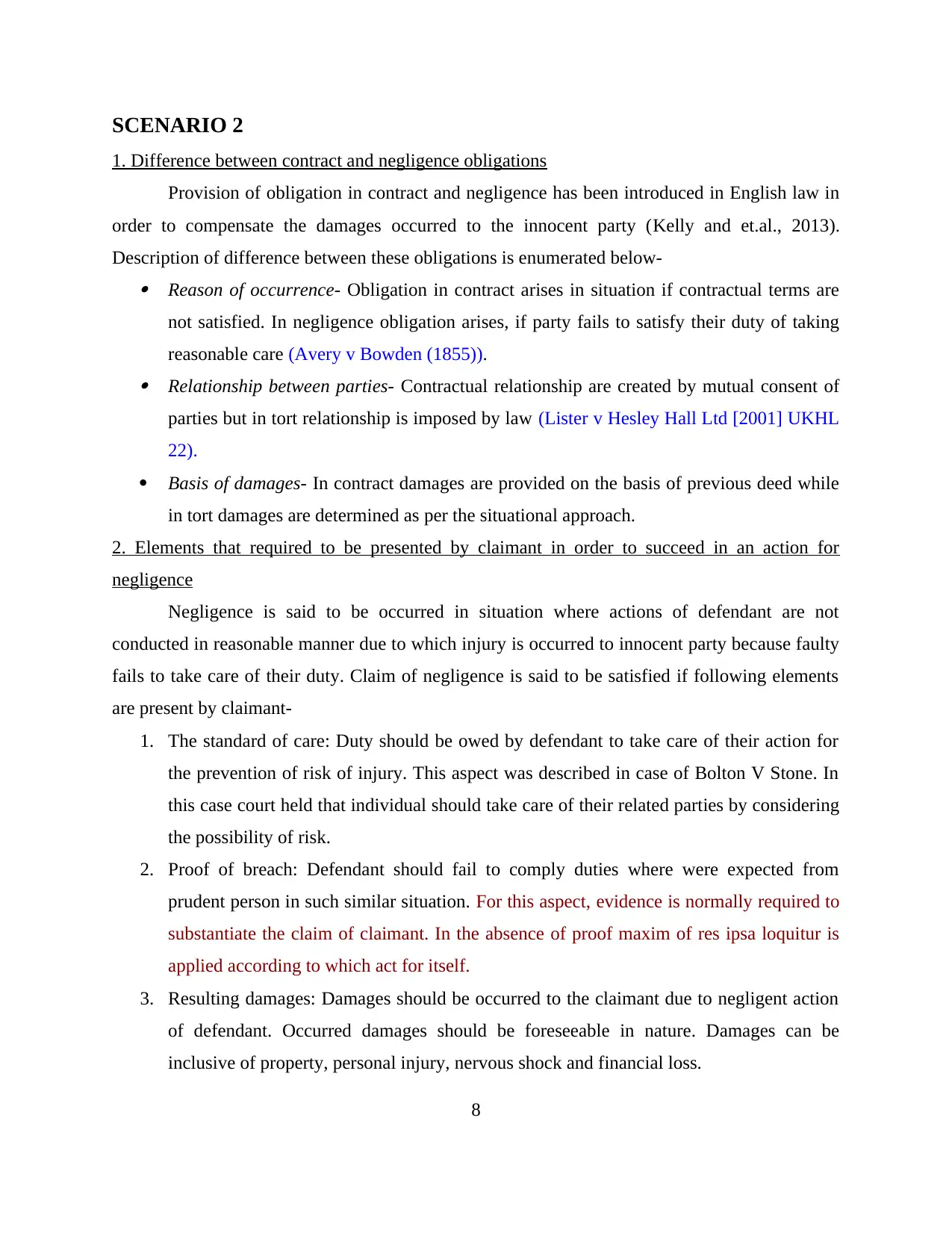
SCENARIO 2
1. Difference between contract and negligence obligations
Provision of obligation in contract and negligence has been introduced in English law in
order to compensate the damages occurred to the innocent party (Kelly and et.al., 2013).
Description of difference between these obligations is enumerated below- Reason of occurrence- Obligation in contract arises in situation if contractual terms are
not satisfied. In negligence obligation arises, if party fails to satisfy their duty of taking
reasonable care (Avery v Bowden (1855)). Relationship between parties- Contractual relationship are created by mutual consent of
parties but in tort relationship is imposed by law (Lister v Hesley Hall Ltd [2001] UKHL
22).
Basis of damages- In contract damages are provided on the basis of previous deed while
in tort damages are determined as per the situational approach.
2. Elements that required to be presented by claimant in order to succeed in an action for
negligence
Negligence is said to be occurred in situation where actions of defendant are not
conducted in reasonable manner due to which injury is occurred to innocent party because faulty
fails to take care of their duty. Claim of negligence is said to be satisfied if following elements
are present by claimant-
1. The standard of care: Duty should be owed by defendant to take care of their action for
the prevention of risk of injury. This aspect was described in case of Bolton V Stone. In
this case court held that individual should take care of their related parties by considering
the possibility of risk.
2. Proof of breach: Defendant should fail to comply duties where were expected from
prudent person in such similar situation. For this aspect, evidence is normally required to
substantiate the claim of claimant. In the absence of proof maxim of res ipsa loquitur is
applied according to which act for itself.
3. Resulting damages: Damages should be occurred to the claimant due to negligent action
of defendant. Occurred damages should be foreseeable in nature. Damages can be
inclusive of property, personal injury, nervous shock and financial loss.
8
1. Difference between contract and negligence obligations
Provision of obligation in contract and negligence has been introduced in English law in
order to compensate the damages occurred to the innocent party (Kelly and et.al., 2013).
Description of difference between these obligations is enumerated below- Reason of occurrence- Obligation in contract arises in situation if contractual terms are
not satisfied. In negligence obligation arises, if party fails to satisfy their duty of taking
reasonable care (Avery v Bowden (1855)). Relationship between parties- Contractual relationship are created by mutual consent of
parties but in tort relationship is imposed by law (Lister v Hesley Hall Ltd [2001] UKHL
22).
Basis of damages- In contract damages are provided on the basis of previous deed while
in tort damages are determined as per the situational approach.
2. Elements that required to be presented by claimant in order to succeed in an action for
negligence
Negligence is said to be occurred in situation where actions of defendant are not
conducted in reasonable manner due to which injury is occurred to innocent party because faulty
fails to take care of their duty. Claim of negligence is said to be satisfied if following elements
are present by claimant-
1. The standard of care: Duty should be owed by defendant to take care of their action for
the prevention of risk of injury. This aspect was described in case of Bolton V Stone. In
this case court held that individual should take care of their related parties by considering
the possibility of risk.
2. Proof of breach: Defendant should fail to comply duties where were expected from
prudent person in such similar situation. For this aspect, evidence is normally required to
substantiate the claim of claimant. In the absence of proof maxim of res ipsa loquitur is
applied according to which act for itself.
3. Resulting damages: Damages should be occurred to the claimant due to negligent action
of defendant. Occurred damages should be foreseeable in nature. Damages can be
inclusive of property, personal injury, nervous shock and financial loss.
8
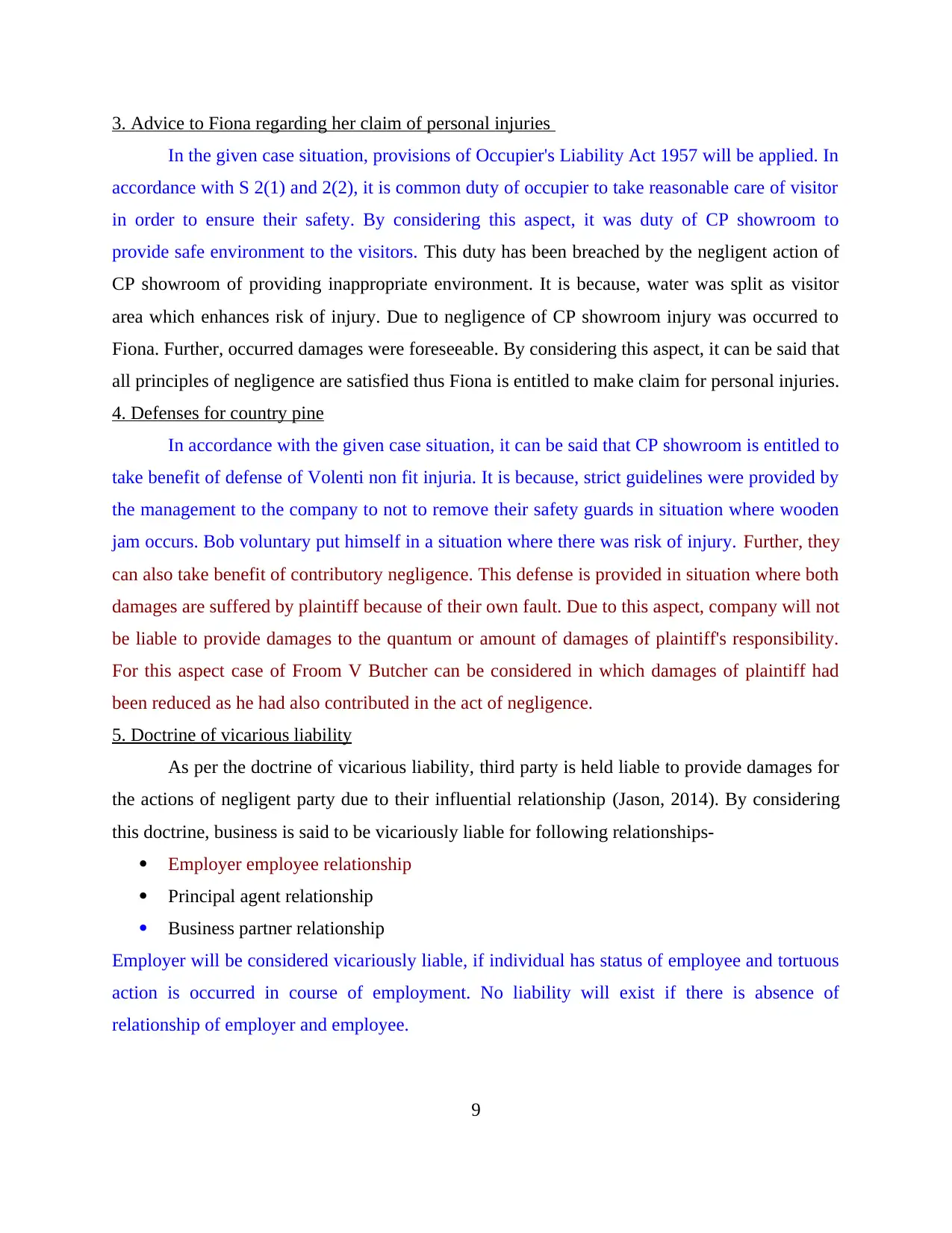
3. Advice to Fiona regarding her claim of personal injuries
In the given case situation, provisions of Occupier's Liability Act 1957 will be applied. In
accordance with S 2(1) and 2(2), it is common duty of occupier to take reasonable care of visitor
in order to ensure their safety. By considering this aspect, it was duty of CP showroom to
provide safe environment to the visitors. This duty has been breached by the negligent action of
CP showroom of providing inappropriate environment. It is because, water was split as visitor
area which enhances risk of injury. Due to negligence of CP showroom injury was occurred to
Fiona. Further, occurred damages were foreseeable. By considering this aspect, it can be said that
all principles of negligence are satisfied thus Fiona is entitled to make claim for personal injuries.
4. Defenses for country pine
In accordance with the given case situation, it can be said that CP showroom is entitled to
take benefit of defense of Volenti non fit injuria. It is because, strict guidelines were provided by
the management to the company to not to remove their safety guards in situation where wooden
jam occurs. Bob voluntary put himself in a situation where there was risk of injury. Further, they
can also take benefit of contributory negligence. This defense is provided in situation where both
damages are suffered by plaintiff because of their own fault. Due to this aspect, company will not
be liable to provide damages to the quantum or amount of damages of plaintiff's responsibility.
For this aspect case of Froom V Butcher can be considered in which damages of plaintiff had
been reduced as he had also contributed in the act of negligence.
5. Doctrine of vicarious liability
As per the doctrine of vicarious liability, third party is held liable to provide damages for
the actions of negligent party due to their influential relationship (Jason, 2014). By considering
this doctrine, business is said to be vicariously liable for following relationships-
Employer employee relationship
Principal agent relationship
Business partner relationship
Employer will be considered vicariously liable, if individual has status of employee and tortuous
action is occurred in course of employment. No liability will exist if there is absence of
relationship of employer and employee.
9
In the given case situation, provisions of Occupier's Liability Act 1957 will be applied. In
accordance with S 2(1) and 2(2), it is common duty of occupier to take reasonable care of visitor
in order to ensure their safety. By considering this aspect, it was duty of CP showroom to
provide safe environment to the visitors. This duty has been breached by the negligent action of
CP showroom of providing inappropriate environment. It is because, water was split as visitor
area which enhances risk of injury. Due to negligence of CP showroom injury was occurred to
Fiona. Further, occurred damages were foreseeable. By considering this aspect, it can be said that
all principles of negligence are satisfied thus Fiona is entitled to make claim for personal injuries.
4. Defenses for country pine
In accordance with the given case situation, it can be said that CP showroom is entitled to
take benefit of defense of Volenti non fit injuria. It is because, strict guidelines were provided by
the management to the company to not to remove their safety guards in situation where wooden
jam occurs. Bob voluntary put himself in a situation where there was risk of injury. Further, they
can also take benefit of contributory negligence. This defense is provided in situation where both
damages are suffered by plaintiff because of their own fault. Due to this aspect, company will not
be liable to provide damages to the quantum or amount of damages of plaintiff's responsibility.
For this aspect case of Froom V Butcher can be considered in which damages of plaintiff had
been reduced as he had also contributed in the act of negligence.
5. Doctrine of vicarious liability
As per the doctrine of vicarious liability, third party is held liable to provide damages for
the actions of negligent party due to their influential relationship (Jason, 2014). By considering
this doctrine, business is said to be vicariously liable for following relationships-
Employer employee relationship
Principal agent relationship
Business partner relationship
Employer will be considered vicariously liable, if individual has status of employee and tortuous
action is occurred in course of employment. No liability will exist if there is absence of
relationship of employer and employee.
9
⊘ This is a preview!⊘
Do you want full access?
Subscribe today to unlock all pages.

Trusted by 1+ million students worldwide
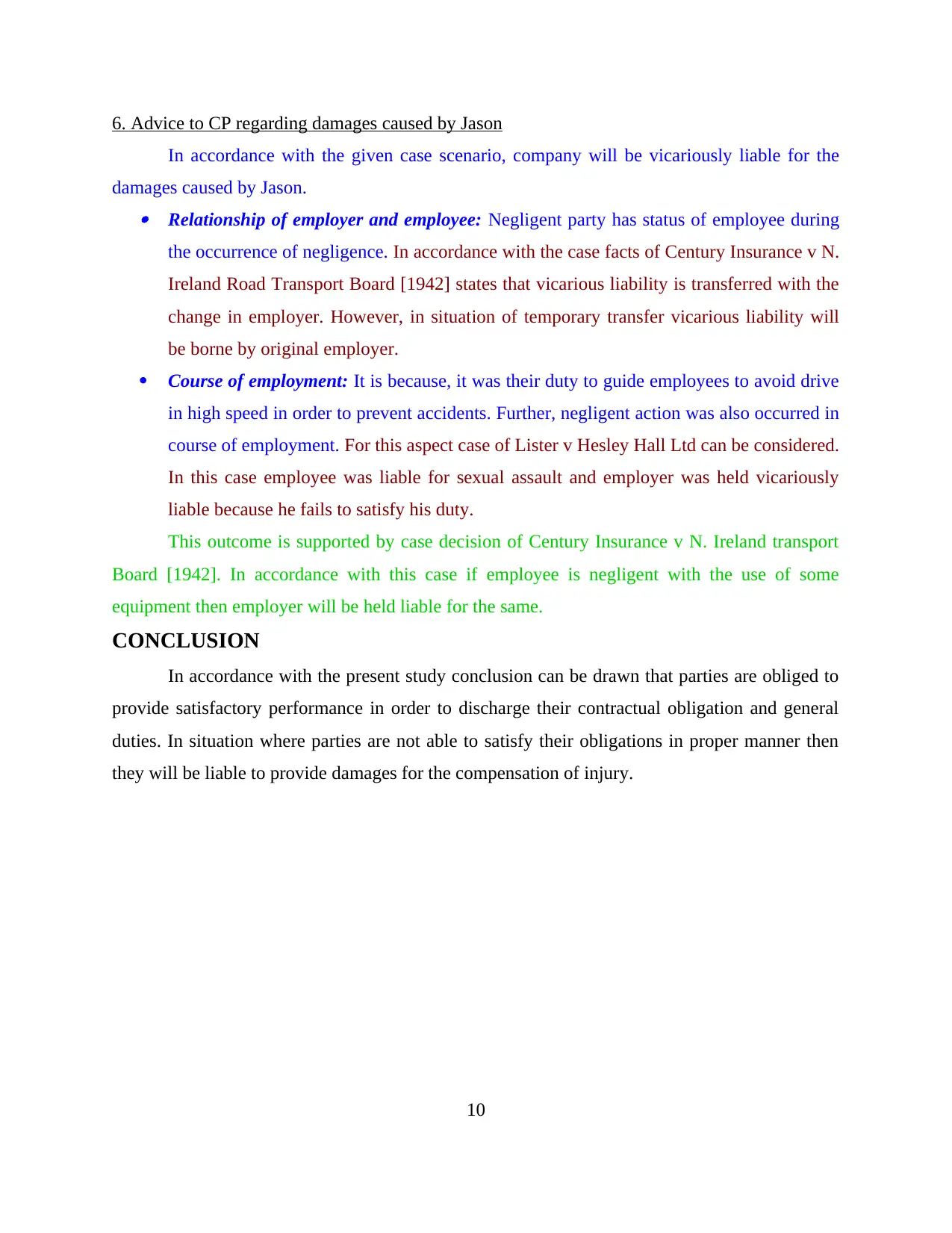
6. Advice to CP regarding damages caused by Jason
In accordance with the given case scenario, company will be vicariously liable for the
damages caused by Jason. Relationship of employer and employee: Negligent party has status of employee during
the occurrence of negligence. In accordance with the case facts of Century Insurance v N.
Ireland Road Transport Board [1942] states that vicarious liability is transferred with the
change in employer. However, in situation of temporary transfer vicarious liability will
be borne by original employer.
Course of employment: It is because, it was their duty to guide employees to avoid drive
in high speed in order to prevent accidents. Further, negligent action was also occurred in
course of employment. For this aspect case of Lister v Hesley Hall Ltd can be considered.
In this case employee was liable for sexual assault and employer was held vicariously
liable because he fails to satisfy his duty.
This outcome is supported by case decision of Century Insurance v N. Ireland transport
Board [1942]. In accordance with this case if employee is negligent with the use of some
equipment then employer will be held liable for the same.
CONCLUSION
In accordance with the present study conclusion can be drawn that parties are obliged to
provide satisfactory performance in order to discharge their contractual obligation and general
duties. In situation where parties are not able to satisfy their obligations in proper manner then
they will be liable to provide damages for the compensation of injury.
10
In accordance with the given case scenario, company will be vicariously liable for the
damages caused by Jason. Relationship of employer and employee: Negligent party has status of employee during
the occurrence of negligence. In accordance with the case facts of Century Insurance v N.
Ireland Road Transport Board [1942] states that vicarious liability is transferred with the
change in employer. However, in situation of temporary transfer vicarious liability will
be borne by original employer.
Course of employment: It is because, it was their duty to guide employees to avoid drive
in high speed in order to prevent accidents. Further, negligent action was also occurred in
course of employment. For this aspect case of Lister v Hesley Hall Ltd can be considered.
In this case employee was liable for sexual assault and employer was held vicariously
liable because he fails to satisfy his duty.
This outcome is supported by case decision of Century Insurance v N. Ireland transport
Board [1942]. In accordance with this case if employee is negligent with the use of some
equipment then employer will be held liable for the same.
CONCLUSION
In accordance with the present study conclusion can be drawn that parties are obliged to
provide satisfactory performance in order to discharge their contractual obligation and general
duties. In situation where parties are not able to satisfy their obligations in proper manner then
they will be liable to provide damages for the compensation of injury.
10
Paraphrase This Document
Need a fresh take? Get an instant paraphrase of this document with our AI Paraphraser
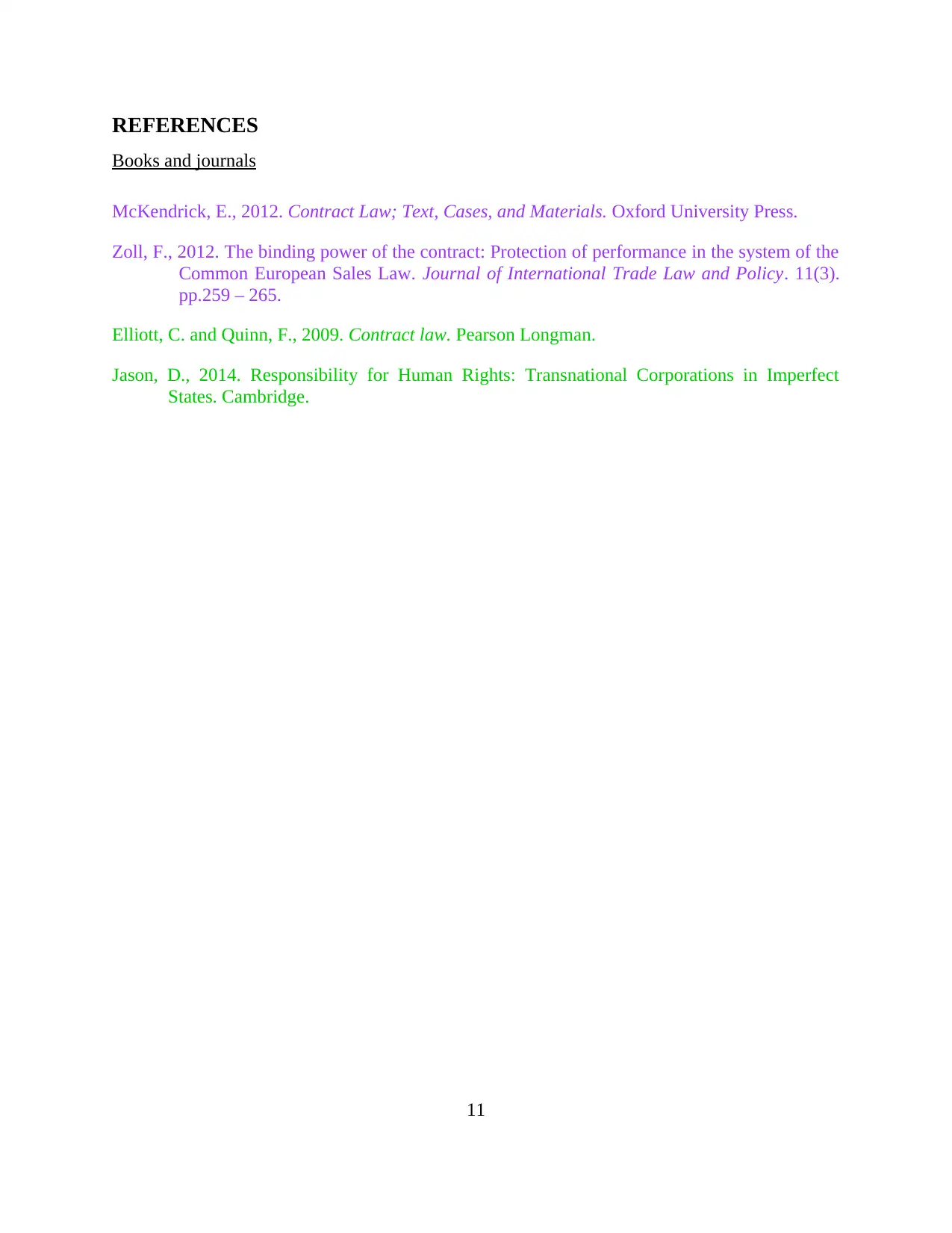
REFERENCES
Books and journals
McKendrick, E., 2012. Contract Law; Text, Cases, and Materials. Oxford University Press.
Zoll, F., 2012. The binding power of the contract: Protection of performance in the system of the
Common European Sales Law. Journal of International Trade Law and Policy. 11(3).
pp.259 – 265.
Elliott, C. and Quinn, F., 2009. Contract law. Pearson Longman.
Jason, D., 2014. Responsibility for Human Rights: Transnational Corporations in Imperfect
States. Cambridge.
11
Books and journals
McKendrick, E., 2012. Contract Law; Text, Cases, and Materials. Oxford University Press.
Zoll, F., 2012. The binding power of the contract: Protection of performance in the system of the
Common European Sales Law. Journal of International Trade Law and Policy. 11(3).
pp.259 – 265.
Elliott, C. and Quinn, F., 2009. Contract law. Pearson Longman.
Jason, D., 2014. Responsibility for Human Rights: Transnational Corporations in Imperfect
States. Cambridge.
11
1 out of 11
Related Documents
Your All-in-One AI-Powered Toolkit for Academic Success.
+13062052269
info@desklib.com
Available 24*7 on WhatsApp / Email
![[object Object]](/_next/static/media/star-bottom.7253800d.svg)
Unlock your academic potential
Copyright © 2020–2025 A2Z Services. All Rights Reserved. Developed and managed by ZUCOL.





